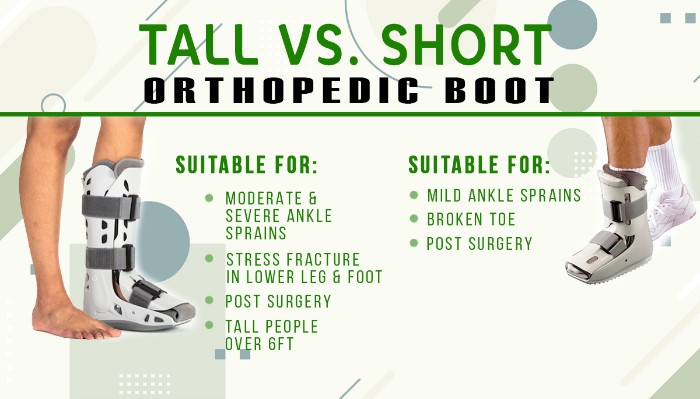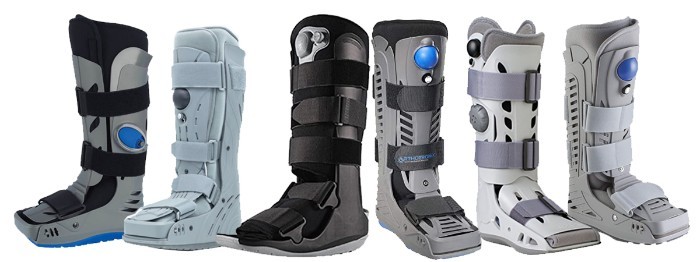Walking Boot (Brace) for Injuries

What is a Walking Boot?
A walking boot (also known as a Walking Brace or an Orthopedic boot) is a type of medical shoe used to protect the foot and ankle after an injury or surgery. The boot can be used to stabilize broken bones, tendon or ligament injuries, severe sprains, or shin splints.
Walking boots are becoming extremely popular now because of their lightweight and sturdy material, medical grade adjustable straps, and removable casing at any time compared to the regular plaster cast where discomforts such as skin irritation, hygiene and odour, and being too tight are usually a problem.
Walking Boot Features:
- Air chambers or bladders that you can inflate with the use of a pump;
- A rigid plastic shell that stabilizes and protects your leg;
- Inner linings that enclose and cushion your foot and ankle;
- Adjustable Velcro fasteners that make the walking boot capable of providing a close fit to a wide variety of foot and ankle sizes and shapes;
- Shock absorption systems reduce the impact of “heel strikes” as your foot hits the ground while you walk.
These features, and others you may find in some models, provide your foot and ankle with a stable and cushioned platform. This permits you to walk and continue your regular functions as your injury heals.
Types of injuries or pain wearing a Walking Boot could be useful for:
- Sprained ankle
- Stress fracture in the foot or ankle
- Fibula fracture
- Postoperative use
- Metatarsal fracture
- Lisfranc injuries
- Broken foot or an
- Achilles injuries
- Calf muscle tear
- Shin splints
Tall vs. Short Walking Boot: What’s the Difference?
There are two primary types of walking boots - The tall boot that extends to the knee, and the short boot that reaches halfway between the foot and knee. While both versions have their benefits, shorter people may find the tall version uncomfortable to wear due to lack of mobility. The shorter version is easier to walk in but provides less support for the foot and ankle. For one to heal appropriately, one should consider which boot would work best for one’s type of injury. Short walking boots are typical for post-operative foot surgery, metatarsal and digital fractures as well as soft tissue trauma of the foot and ankle. Tall walking boots are common for acute ankle sprains, stress fractures of the lower leg, soft tissue injuries of the lower leg, stable fractures of the foot and ankle and post-operatively.

Pneumatic vs. Non-Pneumatic Walking Boot
Pneumatic walking boots come with either built-in air pumps or handheld air pumps which both inflate the air cells inside of the boot to provide personalized compression, reduce swelling, and provide more foot stability after an injury. It will cost more than a non-pneumatic walker but it will help with comfort and faster healing. A non-pneumatic boot is the cheaper alternative but still provides quite a bit of stability and can provide the right amount of support, especially if you are just suffering from slight heel pain or just had bunion surgery.
Benefits of Using a Pneumatic Walking Boot:
- Inflated air cells provide cushioning to protect and support the injury
- Compression of the air cells can easily be adjusted
- Provides pain relief
- Reduces inflammation and swelling (or edema)
- Helps by contouring around the leg and reducing the movement within the boot
- Promotes faster healing
- Inflated air cells have a massaging effect on your foot every time you take a step.

How to overcome uneven leg length while using the Walking Boot?
Once you start wearing a Walking Boot, you will experience some uneven gait and balance due to your leg length differences. Your regular sandal or shoe worn on your healthy foot might not have the same height as the Walking Boot, causing you to walk with a limp which could lead to knee, hip or back pains. Other complications can include a herniated disc, sacroiliac malalignment, sciatica, functional scoliosis, lumbar facet syndrome, and degenerative joint disease, especially on the longer side.
To prevent this from happening, one of the ways is to add extra insoles or heel lifts inside of your shoe or to wear an orthopedic shoe lift or foot raiser to even out the leg length differences. You will be walking with confidence while maintaining a better posture without straining a side of your body.
Should I wear my walking boot all day?
This will depend on the severity of your injury and your doctor's recommendation. Typically the boot should be left on at all times during the first week and is recommended to be removed only during showering and light motion exercises.
Sleeping in comfort is ideally what everyone wants for a good night's sleep and you may consider removing your boot at night but we strongly advise against it if you are still in the early stages of your recovery. The body naturally enters a state of hibernation when we sleep, causing every muscle to relax. This can be dangerous for those with an injury, as they may not be aware of how their foot is positioned and risk healing improperly.
Sleeping with the boot on will require some fort building skills. Surround the boot with pillows to reduce the risk of displacement and slightly loosen the straps for comfort. You may also place a pillow under the injured leg to raise it higher to help with blood circulation and prevent swelling. If your doctor gives the green light to remove your boot at night, repeat the same pillow fort and elevate your leg.
Where to buy high quality medical equipment and supplies?
Visit our online store at www.neolee.com.my
Customer enquiries:
Phone: (KL) 03-92129402 / (JB) 07-5190350
Email: general.enquiry@neolee.com.my
or Visit our showroom
For more stories like this, join our Facebook community on Facebook
Need help with your order? chat with us here via Whatsapp
Nov 11,2022
